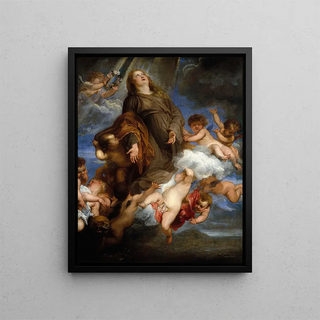Art print | Sainte Rosalie interceding for the plague victims of Palermo - Antoine van Dyck


View from behind

Frame (optional)
Art print of Saint Rosalie interceding for the plague victims of Palermo - Antoine van Dyck – Captivating introduction
In the vast panorama of art history, certain works transcend their era to become symbols of devotion and humanity. "Saint Rosalie interceding for the plague victims of Palermo" by Antoine van Dyck is one such creation that, through its visual power and poignant message, continues to move contemporary viewers. Created in the 17th century, this painting evokes the iconic figure of Saint Rosalie, patroness of Palermo, who, according to legend, saved the city from the plague through divine intercession. This piece, both religious and humanist, invites reflection on suffering and redemption, while offering a captivating glimpse into the beliefs of the time.
Style and uniqueness of the work
Van Dyck's style is distinguished by its rich chromatic palette and keen sense of movement. In "Saint Rosalie interceding for the plague victims of Palermo," the artist deploys a vibrant color scheme that lends the scene dramatic intensity. The sumptuous drapery and expressive figures, imbued with deep emotion, demonstrate his talent for capturing the human psyche. The composition, balanced and harmonious, guides the viewer's gaze toward the saint, who, in a gesture of supplication, appears to call for divine mercy. The subtly blurred background enhances the sense of intimacy and urgency of the scene, immersing the viewer in an atmosphere that is both sacred and tragic. This painting is not only a religious representation but also a work of art that questions the relationship between man, suffering, and faith.
The artist and his influence
Antoine van Dyck, a pupil of Rubens, is often celebrated for his ability to merge the grandeur of the Baroque with personal sensitivity. His career, marked by stays at the English court, profoundly influenced portraiture and religious painting of his time. In "Saint Rosalie interceding for the plague victims of Palermo," one can observe how van Dyck manages to

Matte finish

View from behind

Frame (optional)
Art print of Saint Rosalie interceding for the plague victims of Palermo - Antoine van Dyck – Captivating introduction
In the vast panorama of art history, certain works transcend their era to become symbols of devotion and humanity. "Saint Rosalie interceding for the plague victims of Palermo" by Antoine van Dyck is one such creation that, through its visual power and poignant message, continues to move contemporary viewers. Created in the 17th century, this painting evokes the iconic figure of Saint Rosalie, patroness of Palermo, who, according to legend, saved the city from the plague through divine intercession. This piece, both religious and humanist, invites reflection on suffering and redemption, while offering a captivating glimpse into the beliefs of the time.
Style and uniqueness of the work
Van Dyck's style is distinguished by its rich chromatic palette and keen sense of movement. In "Saint Rosalie interceding for the plague victims of Palermo," the artist deploys a vibrant color scheme that lends the scene dramatic intensity. The sumptuous drapery and expressive figures, imbued with deep emotion, demonstrate his talent for capturing the human psyche. The composition, balanced and harmonious, guides the viewer's gaze toward the saint, who, in a gesture of supplication, appears to call for divine mercy. The subtly blurred background enhances the sense of intimacy and urgency of the scene, immersing the viewer in an atmosphere that is both sacred and tragic. This painting is not only a religious representation but also a work of art that questions the relationship between man, suffering, and faith.
The artist and his influence
Antoine van Dyck, a pupil of Rubens, is often celebrated for his ability to merge the grandeur of the Baroque with personal sensitivity. His career, marked by stays at the English court, profoundly influenced portraiture and religious painting of his time. In "Saint Rosalie interceding for the plague victims of Palermo," one can observe how van Dyck manages to






